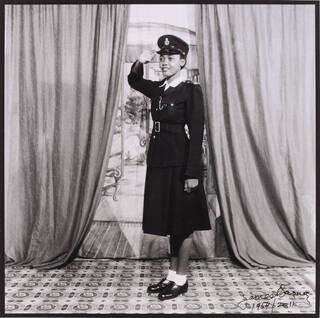With a practice spanning six decades and two continents, ranging from street to studio and fashion to documentary, Ghanaian photographer James Barnor (b. 1929) is now recognised as a pioneering figure within the history of photography.
Moving between Accra and London throughout his life, James Barnor's photographic portraits visually map societies in transition: Ghana winning independence from Britain, and London embracing the freedoms of the swinging sixties.
Born in Accra, Ghana in 1929, Barnor was given his first camera (a Kodak Baby Brownie) at age 17, whilst teaching basket-weaving at a missionary school. Inspired by this new device, he forewent plans to become police officer and started an apprenticeship at his cousin's photography studio. Here began his exceptional career and creative journey.

In 1949, Barnor opened Ever Young studio in the Jamestown district of Accra. His black and white studio portraits taken in the early 1950s capture a nation in flux, on its way towards modernity and independence. In front of painted backdrops and parted curtains, Barnor's clients were invited to memorialise their burgeoning and established personal identities – with the promise of looking 'ever young' thanks to Barnor's renowned photographic retouching skills. The photograph titled Selina Opong, Policewoman #10 illustrates the self-confidence, pride and optimism of a young woman newly entering an urban profession. Through their direct connection with the camera and sophisticated dress, the mother and child depicted in the familiar family-style portrait, Everything in My Hand I Bring (referencing the phrase printed on the mother's kaba and wrapper ensemble) portray a humble sense of self-assuredness.

Barnor also worked as a photojournalist in Accra and was the first staff photographer of the Daily Graphic newspaper. While employed there, he photographed high profile figures such as Kwame Nkrumah, the nation's first leader following independence in 1957; Princess Marina, Duchess of Kent; and Vice-President Richard Nixon, among many others.

In 1959 Barnor relocated to the UK, where he studied photography at Medway College of Art in Kent. Meanwhile, Barnor contributed numerous documentary and fashion photographs to the weekly magazine DRUM. Based in Johannesburg, with London offices on Fleet Street, DRUM was Africa's first black lifestyle magazine and an influential anti-apartheid publication. Barnor's photographs of DRUM models like Eva gave a new face to modern glamour, and contributed to the imagination of a cosmopolitan urban society for DRUM's transnational readership. Through his work for the magazine, Barnor helped redefine the standard for the sensitive portrayal of Black beauty, elegance and style.

Barnor's dynamic vision of London is further reflected through his picture of the BBC's first Black broadcaster, and fellow Ghanaian, Mike Eghan. Photographed amidst a cacophony of neon signs on the steps of the landmark Piccadilly Circus fountain, this picture cements the emergence of a Black cultural presence in Britain. Literally opening his arms, Eghan appears to confidently embrace the energy of this period in London's history as an emerging multicultural city.
After a decade in the UK, Barnor moved back to Ghana in 1970 to help set up the country's first colour-processing laboratory for the company Sick-Hagemeyer, a subsidiary of Agfa-Gevaert. A defining moment in Ghanaian history, Barnor brought colour photography to a broader market than ever before, using the skills he developed during his schooling in the UK.

Taken outside the Agfa-Gevaert lab, Sick-Hagemeyer shop assistant with bottles, taken as a colour guide, has become emblematic of Barnor's pioneering role as a colour practitioner. With vivid red Agfa banners flying behind her, a fashionably dressed shop assistant poses with multicoloured bottles, demonstrating the chromatic possibilities of the newly accessible photographic processes. However, this photograph was never intended to become the icon that it is. Tactically posed with the colourful bottles, Barnor initially conceived of this photograph as a test print to ensure the photographic processing machines were properly calibrating film colours. This photograph was intended to be used as a benchmark for other colour photographs made using the machines. Yet, the striking array of colour and chic 1970s style have made it a colourful symbol of Barnor's groundbreaking work.

In the photograph, Two friends dressed for a church celebration with James's car, two women wearing vivid kente cloth lean against James's red 'Studio X23' car. "Colour really changed people's ideas about photography", says Barnor, "Kente is Ghanaian woven fabric with many different colours, and people wanted their photographs taken after church or in town wearing this cloth, so the news [that colour photography was now accessible in Ghana] spread quickly". Impeccably styled from head to toe, these women fashioned their kente cloth with a 1970s flare make a powerful post-independence statement of pride in their custom.

Equally glamorous, Barnor's close-up of Miss Sophia Salomon harkens to some of his editorial work for DRUM and demonstrates the captivating use of colour in relation to clothing. Salomon's shimmering green and yellow dress leaps off the page and is complimented by the sporadic green shapes dotting the photograph. Caused by deterioration on the original negative from which this photograph was made, the green-coloured shapes aesthetically remind us of the materiality of photography and brilliantly correspond with the dress's green design.
Barnor returned to London in the 1990s and still resides here to this day. He photographed during some of the 20th century's most significant periods of cultural and political change in both Ghana and Britain, and although he only gained recognition for his defining contributions to global photography in the later part of his life, his legacy will exist in perpetuity.
This selection of photographs by James Barnor exists alongside the V&A's growing collection of works by other African photographers including Seydou Keita, Hamidou Maiga and Sanlé Sory.


